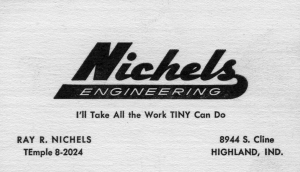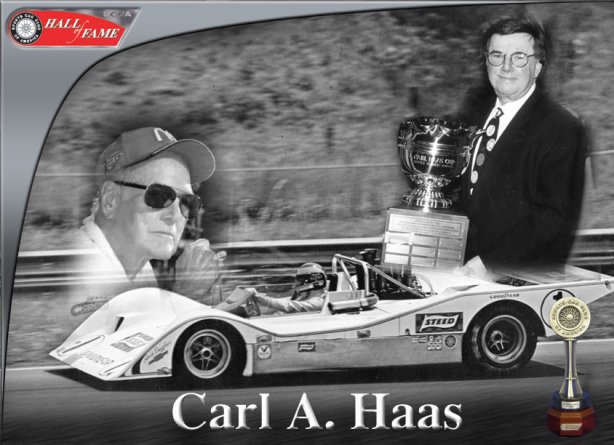Region Racers at the Indianapolis 500 – Dale “Tiny” Worley
By: Wm. LaDow
Although nicknamed “Tiny,” he cast an enormous shadow over much of the American auto racing scene in the 1940s, 1950s, and 1960s.
Dale “Tiny” Worley began his life in the laid-back farming countryside of western Illinois. His life ended abruptly in the Cline Avenue operation of Nichels Engineering while on the phone with Johnny Pawl.
On that sad day in June of 1964, “Tiny” was doing what had been his vocation for almost 25 years: building world-class race cars. So talented at what he did, his employer (and lifelong friend) Ray Nichels printed business cards that sported the words “I’ll Take All the Work that TINY Can Do” just below the nationally recognized Nichels Engineering logo.
Nichels already knew what many would eventually learn — that no one was better at building racecars than “Tiny” Worley.
Getting Started …
 Worley’s first big break in racing came in 1940 when Rudy Nichels, Ray’s father, offered him a mechanic job. By 1941, Tiny had become the chief mechanic for a young Tinley Park, Ill., driver named Melvin Eugene “Tony” Bettenhausen. Worley and Bettenhausen, in the Nichels Service No. 1 Offy Midget, became the scourge of the midget racing ranks across the Midwest.
Worley’s first big break in racing came in 1940 when Rudy Nichels, Ray’s father, offered him a mechanic job. By 1941, Tiny had become the chief mechanic for a young Tinley Park, Ill., driver named Melvin Eugene “Tony” Bettenhausen. Worley and Bettenhausen, in the Nichels Service No. 1 Offy Midget, became the scourge of the midget racing ranks across the Midwest.
After a series of local track championships at Chicago’s Riverview Park Raceway, Blue Island’s Raceway Park, and the Milwaukee Mile with Bettenhausen, Worley became the chief mechanic for Johnnie Parsons’ 1948 Midwest midget car racing championship run.
 With those successes behind him, Tiny moved up to IndyCars. By 1950, he worked for Murrell Belanger’s operation in Lowell and traveled across the country, racing on the AAA Championship Trail. He was a co-chief mechanic in the 1951 Indy 500 with Johnny Pawl. He immediately rejoined the Belanger Team after the 500 to be an integral part of Bettenhausen’s AAA National Championship run in the legendary Belanger No. 99 Kurtis-Kraft. Worley worked the next four Indy-car seasons (and 500s) for Belanger alongside brilliant chief mechanic Frenchy Sirois, wrenching for some of the best drivers in the business, including Jim Rathmann, Art Cross, Paul Russo, and Bettenhausen.
With those successes behind him, Tiny moved up to IndyCars. By 1950, he worked for Murrell Belanger’s operation in Lowell and traveled across the country, racing on the AAA Championship Trail. He was a co-chief mechanic in the 1951 Indy 500 with Johnny Pawl. He immediately rejoined the Belanger Team after the 500 to be an integral part of Bettenhausen’s AAA National Championship run in the legendary Belanger No. 99 Kurtis-Kraft. Worley worked the next four Indy-car seasons (and 500s) for Belanger alongside brilliant chief mechanic Frenchy Sirois, wrenching for some of the best drivers in the business, including Jim Rathmann, Art Cross, Paul Russo, and Bettenhausen.
 In late 1956, Worley returned to work with Ray Nichels, who had founded Nichels Engineering by this time. Ray and Tiny worked and managed three significant motorsports programs. Ray was running sprint car champion Pat O’Connor’s Kurtis-Kraft IndyCar program, managing the Firestone Racing Tire Test Program. Lastly, Nichels Engineering was now the “house” builder for GM-Pontiac’s stock car program.
In late 1956, Worley returned to work with Ray Nichels, who had founded Nichels Engineering by this time. Ray and Tiny worked and managed three significant motorsports programs. Ray was running sprint car champion Pat O’Connor’s Kurtis-Kraft IndyCar program, managing the Firestone Racing Tire Test Program. Lastly, Nichels Engineering was now the “house” builder for GM-Pontiac’s stock car program.
Daytona Double …
In 1957, Tiny Worley’s skills became apparent when, while working with Nichels, he participated in capturing both the pole (with Banjo Matthews) and the race (with Cotton Owens) at Daytona.
The next Nichels Engineering undertaking was the setting of several world closed-course speed records at Monza, Italy, with O’Connor behind the wheel of the Firestone Racing test car and then finally capturing the pole for the Indianapolis 500 with the Nichels Engineering-prepped Kurtis-Kraft No. 12 Sumar Special, also piloted by O’Connor.
During the next six years, Tiny Worley balanced his duties at Nichels Engineering between building championship-winning Pontiac stock cars and magnificently fast IndyCars.
Worley’s involvement with Nichels Engineering allowed him to work with brilliant engineers such as Ted Halibrand of Halibrand Engineering and John DeLorean and Mac McKellar of GM-Pontiac, generating a series of newly engineered racing components, both chassis and powertrain.
When Tiny wasn’t the co-chief mechanic on Nichels’ cars at Indy, he was in charge of his own entries for Bettenhausen, Paul Goldsmith, and Jim Hurtubise. In 1960, Tiny, Ray, and Goldsmith finished third in the 500, and in 1961, Worley’s entry with Hurtubise started the race in the front row.
In 1961 and 1962, Worley’s efforts on the stock car side of the business saw two USAC National Championships captured by Nichels Engineering. In 1962 and ’63, Nichels Engineering-built Pontiacs won National Stock Car Championships in NASCAR.
Famed Pontiac …
Worley and Nichels combined to construct one of the most revered Pontiac stock cars ever built, the Pontiac 421 Super-Duty Tempest LeMans, which beat the competition by more than five miles at Daytona in 1963. So beautifully engineered by Worley, Mercedes-Benz offered to purchase the car from Nichels Engineering. It was so lucrative that Nichels couldn’t pass it up.
Mercedes promptly returned to Germany and dissected the car to learn what Tiny had engineered. Once the documentation had been filed away by the engineers at Mercedes-Benz, the vehicle was destroyed.
Worley’s next engineering milestone was the development of the Nichels Chrysler Hemi in late 1963, early ’64. The results of his work were evident when Goldsmith set a new world closed-course stock car speed record of 174.910 mph, taking the 1964 Daytona 500 pole at almost 15 miles per hour faster than the 1963 Daytona pole winner Fireball Roberts’ qualifying speed of 160.943 mph.
But only a few months later, on June 6, while on the phone with Johnny Pawl, a massive heart attack silenced the 45-year-old Worley forever.
A husband, a father, and a world-class racecar builder, he left this world much too soon.
But not before Dale “Tiny” Worley achieved a lifetime’s accomplishments in his brief time on earth.







You must be logged in to post a comment.